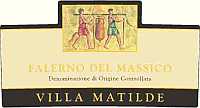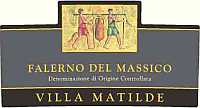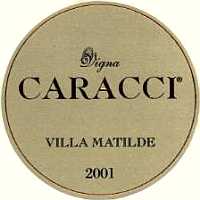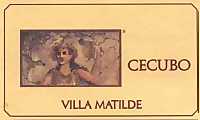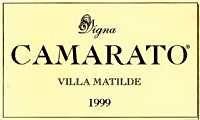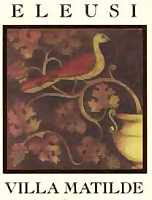|
Falerno, a prestigious wine, very renowned during the times of ancient
Rome, has always been of interests for researchers of the history of enology,
praised and appreciated in ancient times, for a long period it seemed to be
practically disappeared from the wine scene while being bound to his
prestigious fame, almost a legend, of the great times when it had a magnificent
splendor. Falerno sets its roots in classic ancient times. During those times
it was a wine very appreciated and Pliny the Elder believed it had therapeutic
qualities, it was considered by Horace his preferred wine, as well as by Virgil
that in the second book of The Georgics wrote «Nec cellis ideo
contende Falernis» (therefore no wine can be compared to Falerno). Many other
illustrious people of the Roman times praised the qualities and the nobility of
Falerno, whose maximum spreading was promoted during Julius Caesar's times. In
recent times it was appreciated by Russia's Zar and it was the preferred wine
at the court of King Gustave of Sweden and it also became the official wine of
the Palace.
|
| 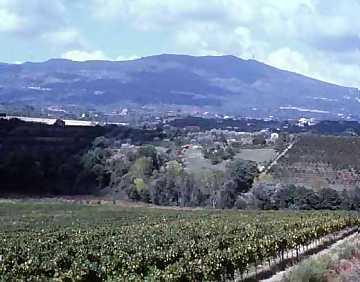 |
| A view from Villa Matilde's vineyards |
|
After having lived a flourishing period of splendor and fame, which continued
until the end of the 1800's, the production of Falerno suddenly stopped for
more than half a century because of the terrible devastations of phylloxera
which destroyed 95% of vineyards. To the catastrophical events of phylloxera
survived few vines which subsequently formed the raw material to which Falerno
would have been reborn thanks to the passion of a Neapolitan lawyer, Francesco
Paolo Avallone, father of Salvatore and Maria Ida, current proprietors of Villa
Matilde, that in his youth was assistant of Roman Law at the University of
Naples and in his studies, done in books written by great classical authors, he
often found mentions and praises for this great wine. Fascinated by the written
witnesses found in the great classical books about Falerno wine, about 45 years
ago, lawyer Francesco Paolo Avallone decided that we would have tried to revive
this legendary wine. Lawyer Avallone began his studies and, with the help of
some researchers of the Agricultural University of Naples, he started a project
whose aim was to find out the proper characteristics of the grapes used in
Roman times for the production of Falerno, by deducting them from the books of
Pliny, Catullus, Columella and all the other authors that directly or
indirectly left witnesses useful to the definition of the grape species to be
used.
As a result of these preliminary researches they started investigating about
the ancient lands of Falerno, in particular the area of “Massico”, in order
to verify whether there still were grapes having the requisites emerged by the
researches. At the end of these investigations they found the vines to be used
and they exactly found 20 vines having the requisites they were looking for: 10
were of Aglianico, that is the ancient Hellenico grape, a vine
introduced in the colonies of ancient south Italy by Greeks, 5 of Piedirosso,
(literally “red foot”), so called because of the characteristic color of the
stem; two variety of grapes that opportunely vinified and aged would have
produced red Falerno, and 5 of Falanghina, the grape used to produce white
Falerno, the famous Vinum Album Phalanginum mentioned in the books of
the renowned Medical School of Salerno. It seems that Falerno name derived from
the deformation of term Phalanginum into Phalernium; therefore it
is probably that the original Falerno wine was white.
By using these few survived vines as a base material on which reviving the fame
of Falerno, it was conducted a patient work on reproduction done by experts
that allowed to save and propagating those few and precious survived vines and
that were saved from the devastations of phylloxera. The vines from which the
needed material for the reproduction was to be used, were scrupulously selected
and grafted in sprouts resistant to phylloxera and then, little by little, they
were successful in replanting the vineyards in the hills of Ager
Falernus that produced for many centuries not particularly abundant harvest
but of the best quality. The original plants are still kept at Villa Matilde
winery and every time it is needed to plant new sprouts, the vines used for the
propagation are directly taken from that old vineyard. Thus, after more than a
century of absence, the first bottles of Falerno got again their way to the
tables of connoisseurs.
The current production of Villa Matilde, besides including the “Falerno del
Massico” wines, also offers other wines, both white and red, produced with
local grapes. Falerno del Massico is produced as white and red by using the
ancient grape composition, faithful to the historical tradition of these wines.
The white is exclusively produced with Falanghina, whereas the red, of which is
also produced in the best years only a reserve as well, is obtained by
Aglianico and Piedirosso grapes. With the very same grapes are also produced
three “mono varietal” wines.
|
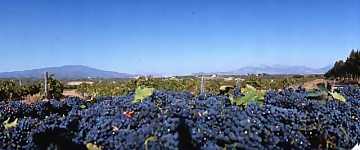 | |
| A vineyard of Villa Matilde | |
|
Concerning the production of white wines, there is “Tenuta Pietre Bianche”, a
young and crisp wine mainly produced with Falanghina and Coda di Volpe. The
“Falerno del Massico Vigna Caracci” is a white wine produced with Falanghina
grape harvested in a tiny vineyard of about three hectares (about 7.5 acres)
and located in the hills near the volcano of Roccamonfina. The grape is
harvested when it is fully ripe in order to exalt the aromatic characteristics
and the wine ages in barrique for about five months. Another white wine
produced by Villa Matilde is “Campostellato”, a particular reserve of
Falanghina produced with selected grapes from which is obtained a particularly
concentrated must, rich in aromas and acidity, that will be transformed in a
full bodied wine.
Talking about the production of red wines there is “Terre Cerase”, obtained
by Aglianico grape, and “Poggio alle More”, produced with Aglianico and Red
Coda di Volpe as well as other local grapes. Result of many years of selections
is “Vigna Camarato”, a wine produced with Aglianico grape harvested in the
vineyard having the same name, one of the oldest and best exposed vineyards in
the estate's hills, located at the base of the volcano of Roccamonfina. The
wine is aged in cask as well as in bottle for 18 months. Another interesting
red is “Cecubo”, produced with Piedirosso, Abbuoto and Primitivo grapes, aged
in cask. With dried Falanghina grapes, left on the plant until November, is
produced “Eleusi”, an excellent late vintage. After the grapes have
been harvested they are allowed to dry in mates under the sun and the must
which is obtained is subsequently fermented and aged in barrique for three
months followed by a long aging in bottle. The production of Villa Matilde is
completed by two grappas, both produced with Falanghina pomace, and olive oil
produced with olives harvested in the winery's estates.
|


